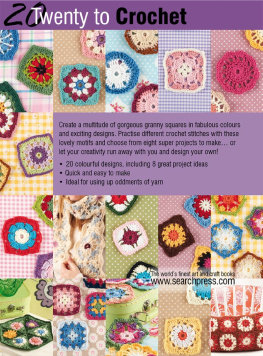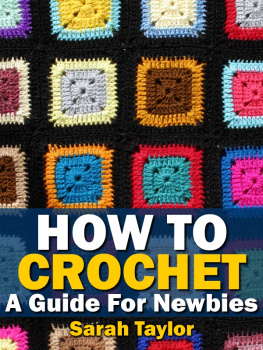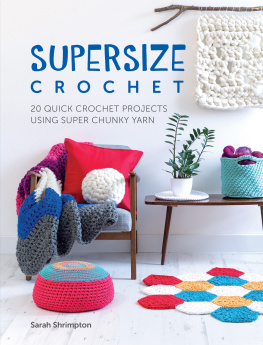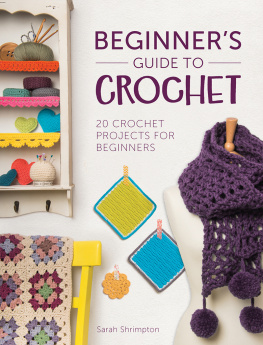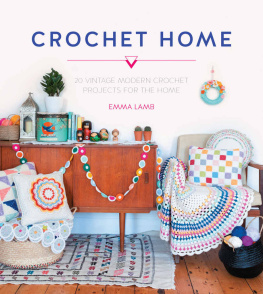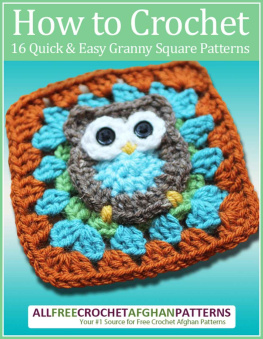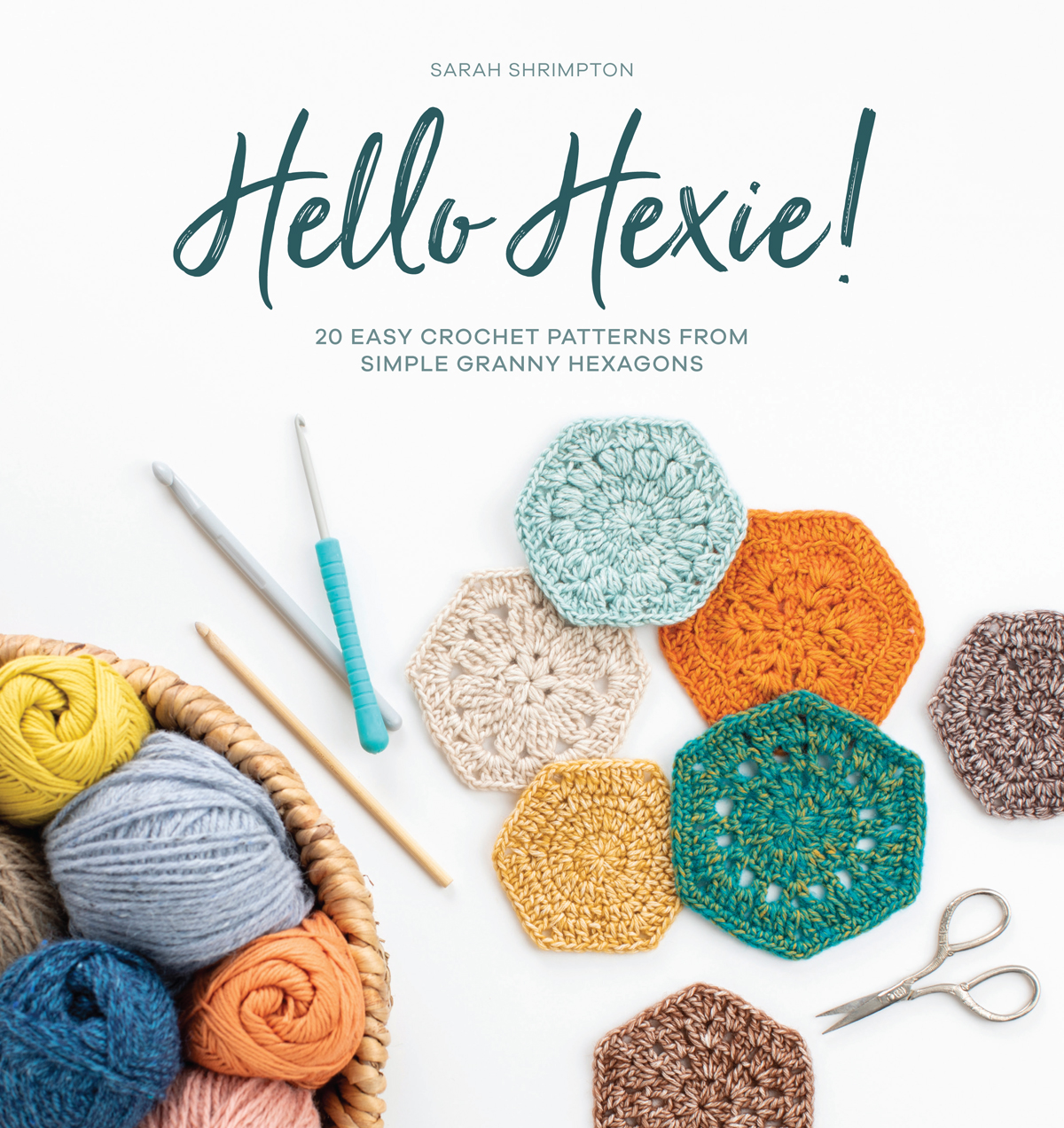Contents
Guide
Pagebreaks of the print version
SARAH SHRIMPTON
Hello Hexie!
20 EASY CROCHET PATTERNS FROM
SIMPLE GRANNY HEXAGONS

www.davidandcharles.com
Contents
Hexagons
Move over, granny square, theres a new kid in town and its about to show you a thing or two about whos cool in crochet.
Now, Ive nothing against granny squares theyre good fun and easy to make, thats for sure but this book is going to prove how much more versatile a hexagon can be. You see, whereas squares can only make square-ish, boxy shapes, a hexagon can be manipulated to create some pretty amazing constructions. Dont believe me? Just take a flick through these pages to find patterns to make socks, mittens, bags and the most divine cardigan, all from the humble hexie.
Before we get started, lets quickly establish the correct terminology for describing a hexagon: the six edges are called sides and the corners are called vertices in their plural form or vertex as singular. Maths lesson over.
This book takes you through ten basic hexagons, with written patterns and charts to guide you. The basic motifs include the solid hexie (best for any project where you dont want holes), the light and airy lacy hexie (perfect for lightweight garments) to the famous African Flower (beautiful and decorative). Theres nothing tricky about crocheting a hexagon of course just think of it as a granny square with two more sides.
The patterns are all based on these, with a few tweaks in between and where needed some half-hexies too. Lots of the projects are created with multiple motifs. Here youll find out about different ways to join them, many will be stitched whilst others are crocheted and some are even joined as-you-go, a technique which saves both time and patience. Others are created from one giant hexie, where rounds are added to the motif until the right size is achieved; perfect for quick and easy projects. The real beauty of the ten patterns is that they can be mixed and matched: if youre not a fan of one motif used in a project, simply swap it for another. You know it will work, because theyre all the same shape.
The projects have been chosen to showcase the hexie and demonstrate exactly what they are all about. Use them to crochet homewares, accessories and garments everything from coasters and placemats to toys, rugs, and blankets. And hexies work in any type of yarn, too. From fine sock-weight yarns to super-chunky merino and just about everything in between. Sizing information for garments is available in the Techniques section.
So what are you waiting for? Lets get hooking hexies!

The Hexie
The hexies in this book are written in joined rounds. This means that unless youre told otherwise the right side of the motif is always facing you. The beginning of each round will start with a chain of stitches to mimic the first stitch and finish with a slip stitch to join.
The ten patterns are written continuously, without colour changes. If you want to change colour at the beginning of a new round, its best to begin in one of the vertices (corners) and simply start from the part of the round which describes a corner turn it will usually look like (tr 1, ch 2, tr 1) in 2ch-sp.
The number in brackets at the end of each round gives the number of stitches (not including chain stitches) for that round.

Motif One: THE GRANNY HEXIE
It seems only fitting that we give a nod to our old friend, the Granny square. Here, instead of a traditional cluster of three treble stitches, we use two, otherwise something very odd happens to the shape!
Rnd 1: ch 4, all in 4th ch from hook: tr 1, ch 1, *tr 2, ch 1; rep from * four more times, sl st to 4th ch to join. (12)
Rnd 2: sl st across into 1ch-sp, (ch 3, tr 1, ch 1, tr 2, ch 1) in same 1ch-sp, *(tr 2, ch 1, tr 2, ch 1) in next 1ch-sp; rep from * around, sl st to 3rd ch to join. (24)
Rnd 3: sl st across into 1ch-sp, (ch 3, tr 1, ch 1, tr 2, ch 1) in same 1ch-sp, tr 2 in next 1ch-sp, ch 1, *(tr 2, ch 1, tr 2, ch 1) in next 1ch-sp, tr 2 in next 1ch-sp, ch 1; rep from * around, sl st to 3rd ch to join. (36)
Rnd 4: sl st across into next 1ch-sp, (ch 3, tr 1, ch 1, tr 2, ch 1) in same 1ch-sp, (tr 2, ch 1) in each 1ch-sp to vertex, *(tr 2, ch 1, tr 2, ch 1) in next 1ch-sp, (tr 2, ch 1) in each 1ch-sp to vertex; rep from * around, sl st to 3rd ch to join. (48)
Rnds 5 onwards: rep rnd 4.

Motif Two: THE SOLID HEXIE
With the only gaps being at its corners, this motif is good for solid projects, where you need stability and structure.
Rnd 1: ch 2, dc 6 in 2nd ch from hook, sl st to 1st dc to join. (6)
Rnd 2: ch 3 (counts as tr 1 here and throughout), tr 1 in same st as ch 3, ch 1, *(tr 2, ch 1) in next st; rep from * around, sl st to 3rd ch to join. (12)
Rnd 3: ch 3, tr 1, (tr 1, ch 2, tr 1) in 1ch-sp, *tr 2, (tr 1, ch 2, tr 1) in 1ch-sp; rep from * around, sl st to 3rd ch to join. (24)
Rnd 4: ch 3, *tr 1 in each st to 2ch-sp, (tr 1, ch 2, tr 1) in 2ch-sp; rep from * around, tr 1 in each st to end, sl st to 3rd ch to join. (36)
Rnds 5 onwards: rep rnd 4.

Motif Three: THE LACY HEXIE
Tall stitches and chain stitches create this modern lace motif.
Rnd 1: ch 5, all in 5th ch from hook: dtr 2, ch 2, *dtr 3, ch 2; rep from * four more times, sl st to 5th ch to join. (18)
Rnd 2: ch 4, dtr 2, (dtr 1, ch 3, dtr 1) in 2ch-sp, *dtr 3, (dtr 1, ch 3, dtr 1) in 2ch-sp; rep from * around, sl st to 4th ch to join. (30)
Rnd 3: ch 5 (counts as dtr 1 and ch 1), sk 1 st, dtr 1, ch 1, (dtr 2, ch 3, dtr 2) in 3ch-sp, ch 1, sk 1 st, *dtr 1, ch 1, sk 1 st, dtr 1, ch 1, sk 1 st, (dtr 2, ch 3, dtr 2) in 3ch-sp, ch 1, sk 1 st; rep from * around, sl st to 4th ch to join. (36)





